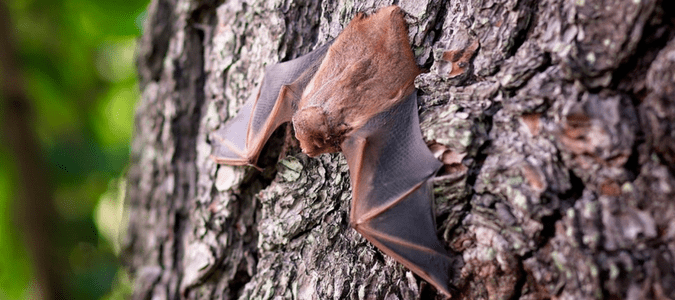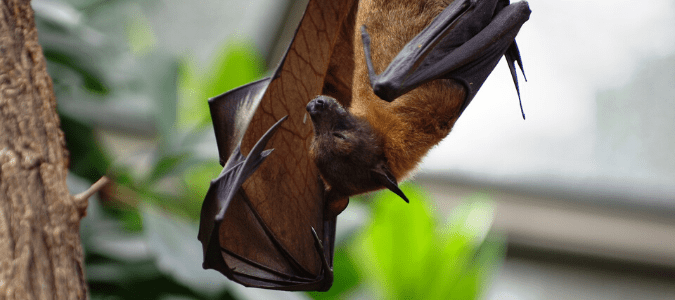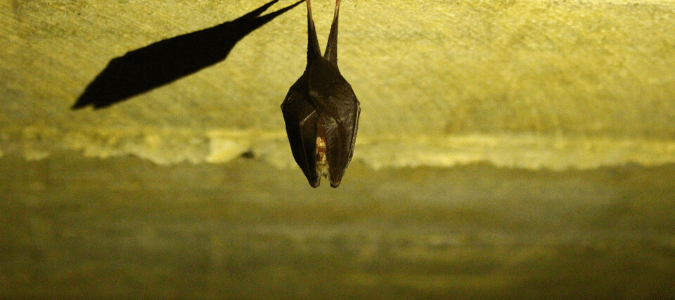Bats are intriguing creatures to learn about. They’re known for their echolocation capabilities and being nocturnal by nature.
Bats possess incredible talents, which could be vital in survival situations like natural disasters. But have you ever considered whether bats hibernate like other mammals do?
Hibernation is an instinctual behavior used by animals during winter to conserve energy and survive harsh conditions. Of the over 1,400 bat species globally, only some hibernate. When they do, they might find comfort within your home or nearby spaces such as backyard sheds or treehouses.
Do Bats Hibernate?
During the winter months, when food becomes increasingly scarce, bats enter a state known as torpor. Their heart rates and breathing slow, their metabolic rates diminish, and body temperatures decrease to conserve energy and resources.
Hibernation allows bats to survive winter weather by tapping into their fat reserves while resting. However, not all species hibernate; some fly south, searching for warmer climates during this season. Warmer environments with more stable temperatures allow bats to find more plentiful food sources while escaping harsh winter conditions.
In contrast, others relocate in search of locations with favorable environments that allow for mating and giving birth to young, along with improving hibernation patterns.
Where Are Bats Habitats Found?
Bats can be found throughout the world except in extremely cold climates and are commonly known to inhabit various habitats, including:
- Caves
- Rock crevices
- Trees
- Buildings
- Underground Tunnels
Bat species vary considerably when it comes to living arrangements. Some prefer large colonies, while others roost or rest alone. Bats are highly adaptable creatures that thrive across many habitats, from deserts to rainforests.
Do Bats Live in Trees?
Bats tend to find shelter from predators and the elements by living in trees during their daytime rest or roost periods, providing natural protection.
Bats utilize trees as food sources, feeding on insects attracted to flowers or leaves, or in the case of fruit bats, eating the fruit from the trees themselves.
Furthermore, some bat species roost within tree cavities that provide safe nesting spots.
They inhabit many trees depending on the bat species and their environment. Certain bats prefer dead or dying trees, while others favor live ones with hollows or cavities for sheltering and resting purposes.
Additionally, they may roost anywhere from trees’ bark and crevices to cracks in buildings; specific tree species like oak, ash and beech trees have been identified as preferred resting locations by certain bat species.
Bats Are Well Known for Their Unique Mating Habits
Bats are widely known for their distinctive breeding behaviors, as their reproductive cycles can adjust based on food availability and environmental conditions. This makes bats one of the only mammals known to breed all year round.
Female Bats
Females typically possess the ability to store sperm for extended periods, making their eggs fertile when conditions are favorable for raising young. Furthermore, some bat species can breed multiple times per year, further increasing their reproductive potential.
Most female bats give birth annually, usually during spring or summer months, within large colonies that share communal roosts; others may give birth individually.
Male Bats
To gain the attention of females during the breeding season, male bats display elaborate courtship behaviors like singing, fighting, or marking their territory to win their attention.
Female bats typically select multiple partners during each breeding season. Since bats live for many years and reproduce over multiple generations, locating suitable habitats is key in aiding breeding routines.
Bat Entry Points: How They Get In and Around Your Home
If you discover bats near or in your home, it is best not to panic and remain calm. Bats are essential to our ecosystem and are generally non-aggressive until threatened. Here are a few steps that might help:
- Find bat entry points. Investigate potential entryways into your home where bats may enter. These could include holes and gaps along its exterior where bats may enter through holes, including high places such as attics, window frames, large beams or house siding.
- Once you’ve identified entry points, seal them to prevent more bats from entering.
- Contact bat control. Professional pest control experts offer bat removal solutions for those unsure how to remove bats from their homes. Experts possess all the appropriate tools and gear necessary for removal, ensuring a swift process with zero risks of mistreatment.
Bats are protected under the law in many places. As such, pest control specialists need to be called to remove them. They understand how to deal with bats without disturbing their delicate ecosystem balance.
Moreover, bats carry diseases such as rabies that could endanger human health while damaging property by nesting within walls or attics and creating fire hazards. So choosing a pest control specialist better equipped to deal with the issue is wise.
How To Stop Bat Nests on Your Property
To discourage bat nesting on your property, follow these steps. First, seal off all potential opening points for bats, such as cracks or crevices in your house that could provide access to bats. These could include openings such as:
- Cracks
- Crevices
- Holes
- Loose Siding
If you want to be creative, installing bat boxes or structures outside your home to provide bats an alternative place to rest can also shelter them and provide them with roosting spots.
Limit outdoor lighting at night to deter insects which, in turn, attract bats.
Or speak with a pest control specialist since bats can be invasive in many locations. Any actions you take must consider any applicable local laws or regulations before taking any drastic measures against bats.
To avoid future bat nestings on your property, try keeping it clear of clutter, piles of wood or debris to discourage bats from nesting there.
Why Did Bats Select Your Home?
Bats may choose your home for various reasons, such as shelter in times of high humidity. They could find comfort there, too, if conditions in their environment weren’t appropriate—such as providing them with warmth and dry conditions to rest.
Shelter
Bats are drawn to homes that provide them with food, water and shelter. That could mean in your house, where there may be all three amenities at any time each night, making yours the ideal location. Your house might provide these resources reliably enough for bats to settle there as a home.
Bat’s disease risk depends upon their environment and individual bat, though some species of bats can carry infectious diseases like rabies.
Bats produce unsightly droppings known as guano due to their diet of high-protein food sources that produce lots of waste products and release waste through excrement production. Bat poop also poses health hazards because it may contain fungal spores that cause respiratory infections in people.
Roosting Sites
Bats may find your home an appealing roosting site because it provides them with a protected place to sleep during the day, not to mention being drawn in by its warmth and darkness.
Furthermore, attics or enclosed spaces could prove irresistibly inviting environments for bats looking for somewhere to roost.
To prevent bats from taking up residence inside your home, seal all entry points that they might use as entryways and consider providing alternative roosts, such as bat houses in nearby trees.
They may also be drawn to areas with plenty of insect and plant activity as bats are known predators of these pests; more wildlife may attract bats as it provides food.
If your property already has an infestation of bats, contact a pest control specialist to remove them while cleaning up after them.
The Bottom Line
Bats are indispensable ecosystem members, contributing significantly to biodiversity through hibernation and providing safe places to roost and raise their young.
You must take preventative steps to discourage bats from nesting near or within your property, such as keeping areas clear of clutter. Doing this will eliminate food sources for them while making your property less inviting.
If you notice bat infestations in your home or property, contact a professional pest control service to remove them.
ABC Can Make Your Property Bat-free Again
While there are some benefits of bats, you definitely don’t want them nesting on your property. If you need help with bats, contact ABC Home & Commercial Services. Our pest control team can create a plan to get rid of these creatures.


